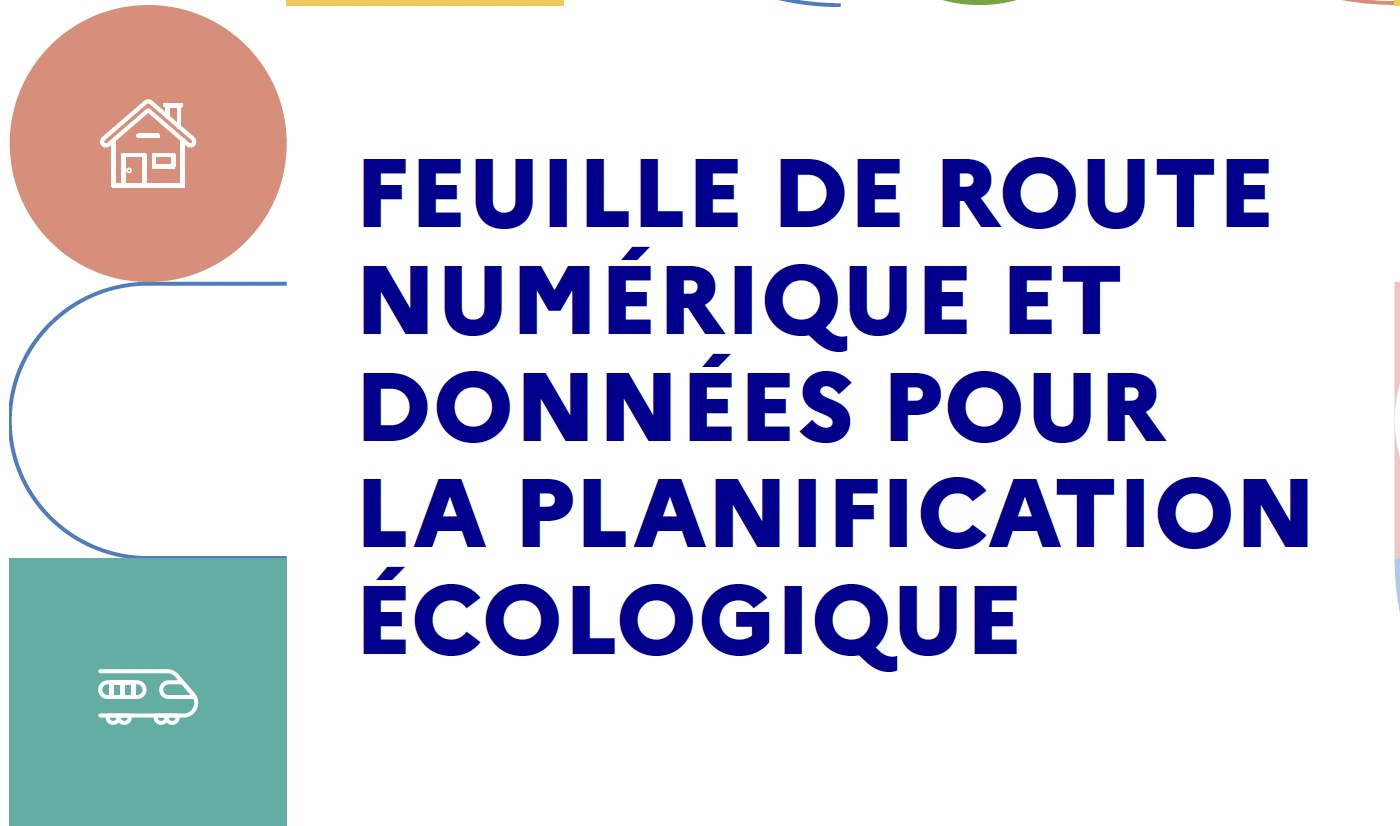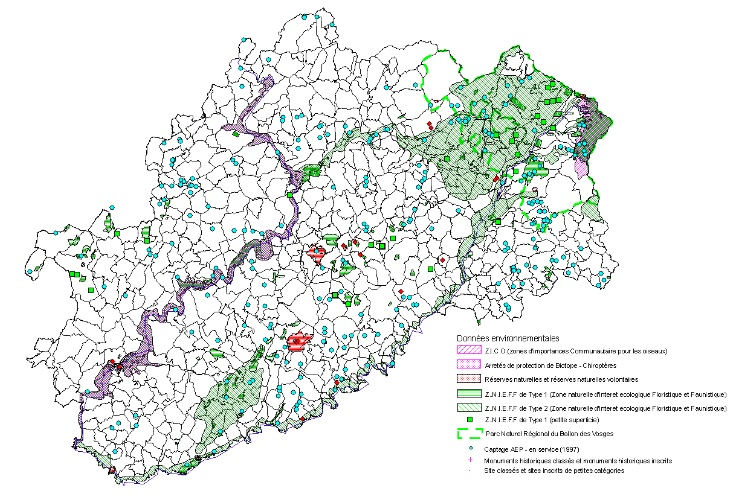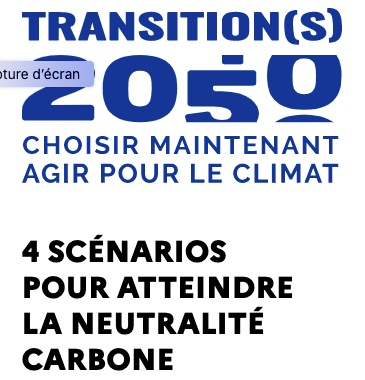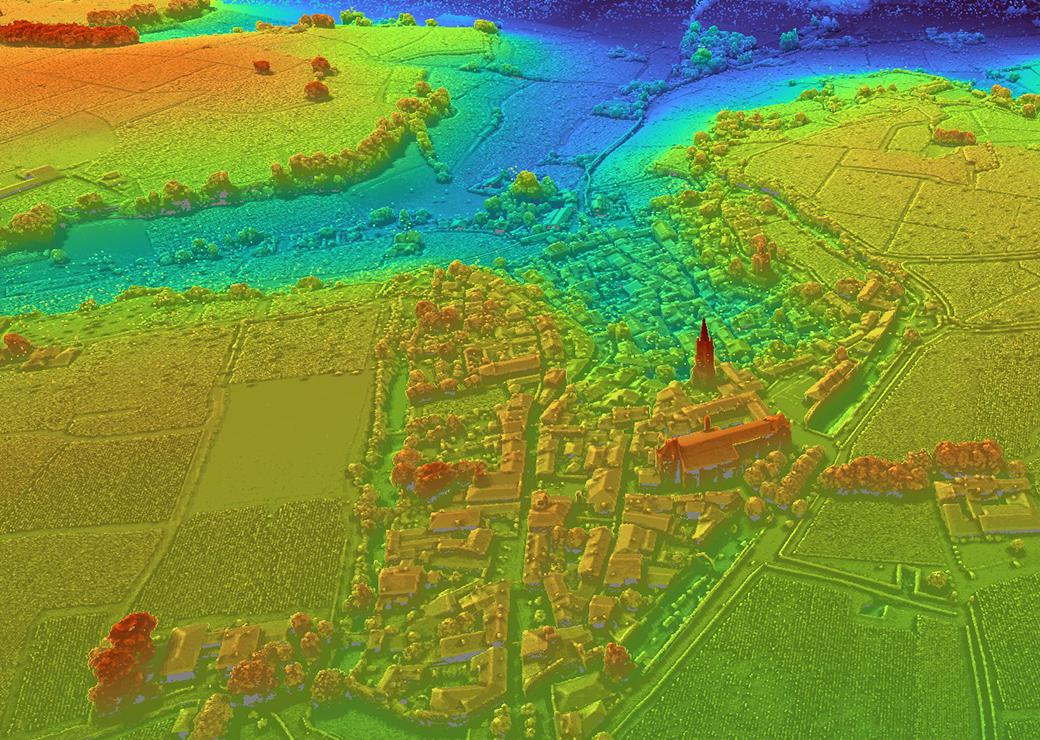« Without digital technology and data, there will be no massive deployment of renewable energies, no development of car-sharing, no traceability of waste management or fine-tuned monitoring of phytosanitary products, no consideration of protected species in urbanization decisions, no measurement of our environmental footprint, no proactive targeting of aid to the most precarious citizens, no transparency on the impact of our consumption choices, no enlightened management of water resources, no shared information enabling participation in public decision-making or quite simply no IPCC report »
In December 2023, the General Secretariat for Ecological Planning (SGPE) published a proposed roadmap entitled "Digital and data for ecological planning".
Drawn up with the help of more than 300 national and local public-sector employees, this roadmap suggests ways, sector by sector, to make better use of available data and ensure that it is shared for the purposes of steering and analyzing public policies.
This dense document (259 pages) identifies and details a total of 147 actions.
Référence :
" Digital technology must help change the current system, not optimize it even further".
In an introduction in the form of a manifesto, the authors of the roadmap address, at length, the raison d'être (the "why?") of this roadmap: " Faced with the major, systemic challenge represented by the ecological transition, and given the urgency with which we must act, digital technology is an indispensable tool for targeting the most effective actions, managing complexity, reducing delays, modeling, anticipating crises, networking and mobilizing (...) Digital technology must help change the current system, not optimize it even further".
They go on to explain the method (the "how") of implementing the roadmap: "For a digital project to be a success, it is often necessary for a large number of players to do their part in a coordinated fashion (developing the necessary standards, making the data available, creating the interface, deploying the tool, training users...) ".
As part of the "public platform" approach that underpins the roadmap, " the public authorities lay down the basic rules governing the ethics, security and interoperability of digital tools. It also builds the basic infrastructures. These are identity or business databases, which are distributed in open data or shared with a given circle of players via ad hoc infrastructures. These foundations must be robust and pragmatic. Without them, everything else is built on sand".
This public platform approach "allows roles to be shared between the public and private sectors. (...) This collaboration takes the form of shared digital bricks, monopolized by the public sector in the relevant geographical area, to which digital services are connected, often in the private, competitive sector".
Eight themes mapped
The work was structured around the eight themes of France Nation Verte's ecological planning. These are: "better mobility", "better housing", "better resource conservation", "better biodiversity conservation", "better production", "better nutrition", "better consumption" and "transversal".
To visually represent the roadmap's objectives and projects, the authors used the metaphors of buildings and "bricks" to map each of the eight themes.
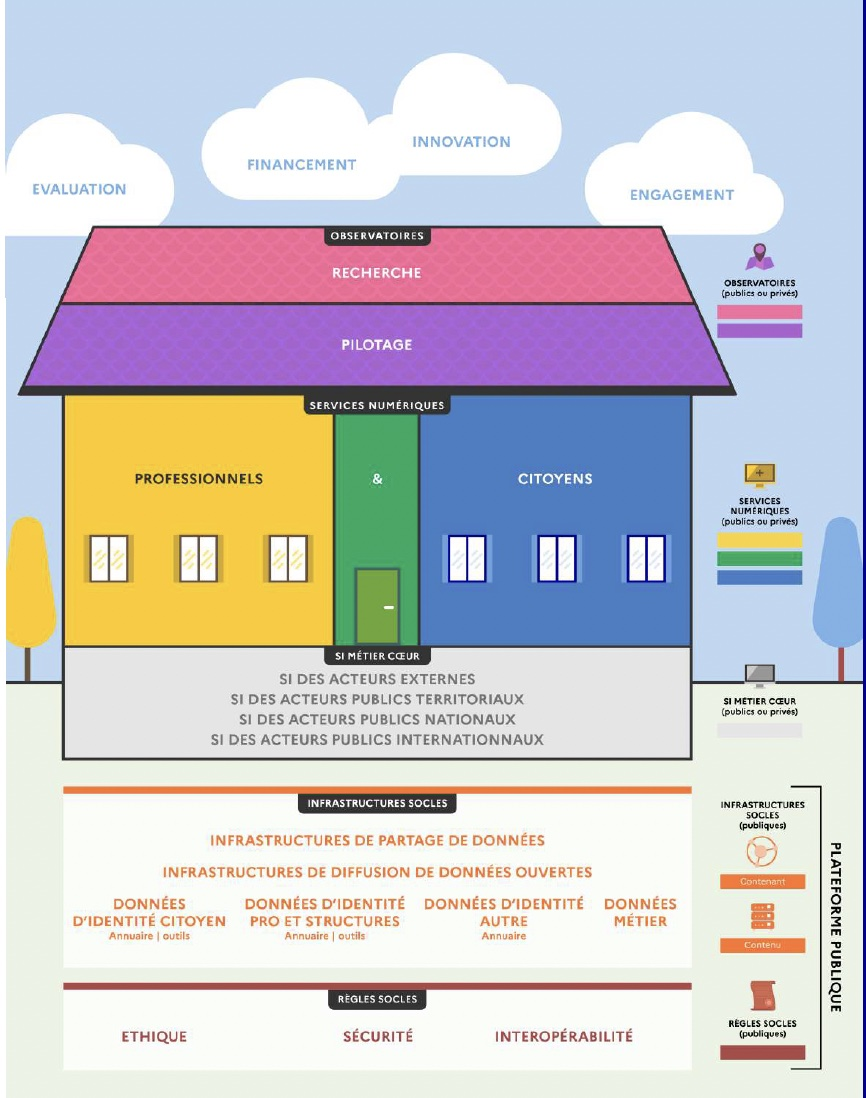
Each theme (building) is thus associated with several types of "digital bricks": foundations (rules and infrastructure), "walls" (digital services), roof (observatories). "Each brick rests on those below. Dysfunctions observed on the tip of the iceberg, such as the lack of interoperability of digital services (building walls) or the lack of consistency in observatory data (building roof), are very often due to dysfunctions or the absence of robust foundations".
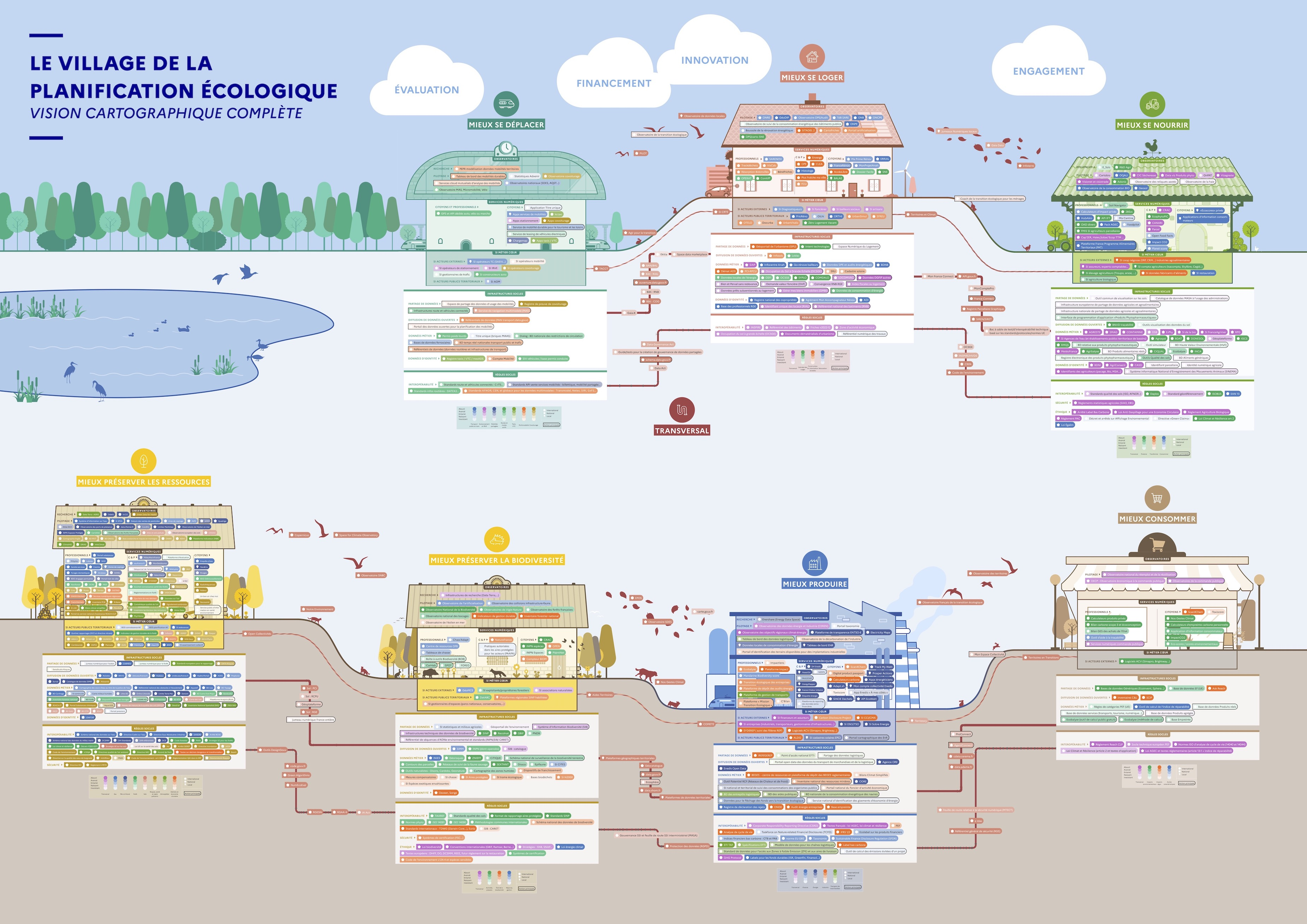
Each of the 147 areas identified as priorities is the subject of a numbered "action". Each action is documented: business challenges, current situation, sub-actions to be undertaken, initiators (central administrations, operators, territories), a main initiator and an indicative timetable.
And use cases for each theme
In addition, each of the eight themes is associated with use cases that the roadmap is designed to address as a priority:
- Getting around: "Analyzing and planning mobility
- Better housing: "Energy consumption in housing", "Improving the citizen's approach to renovation".
- Better preserve resources: "Forecasting water resources and managing crises", "Managing coastline recession".
- Better preservation of biodiversity: "Taking biodiversity into account in urban planning decisions".
- Better production: "Efficient deployment of renewable energies".
- Better nutrition: "Enhancing soil quality
- Better consumption: "Making environmental cost measurement more reliable and harmonized".
- Cross-functional use cases: "Tooling citizens", "Tooling territories".
Each use case explains the business challenges and the current state of digital tools and associated data, as well as the impact indicators.
"This work on use cases makes it possible to define the priority actions for the theme. Conversely, cartographic work enables us to know everything that exists (...) and to think about the urbanization of bricks in a systemic way: who relies on what? who needs to be interoperable with what?".
Identify missing bricks or bricks to be consolidated
The main contribution of this roadmap is that it reveals "these underground bricks to initiate, unblock, secure or accelerate their development and integration into all the higher bricks". In this way, it tackles "several sea snakes whose smooth operation is essential if we are to professionalize, industrialize and rapidly scale up to meet the ecological emergency".
Key identifiers (such as premises and building identifiers, or agricultural parcel identifiers), business databases (such as real-time public transport information, soil quality, environmental impacts of real food products, or data on the reparability, durability and environmental impact of real products) are among the bricks that are missing or need to be reinforced.
"Move the governance of the digital commons towards more public models, or create them where they don't exist".
"All the themes highlighted the need to share data between a restricted circle of private and public players in order to implement their ecological planning policies. The roadmap highlights the importance of data dissemination infrastructures, which enable open data to be distributed securely and within a legal framework, and to be shared or made accessible to a restricted circle of players, when they are not intended to be open.
"Historically, to meet this need, it has often been external private or associative players who have built the necessary sharing infrastructures. However, the associated governance poses problems of continuity, sovereignty and neutrality. To enable the deployment of these infrastructures and the industrialization of the associated public policies, it is therefore essential to move their governance towards more public models, or to set them up where they do not exist. Private digital players can contribute to building these infrastructures, but as service providers, not on their behalf, without which the criteria (continuity, sovereignty) cannot be guaranteed.
Rationalizing observatories to monitor and steer ecological planning
"The proliferation of public and private observatories makes it difficult to monitor and assess the impact of actions taken". This proliferation of observatories corresponds to the proliferation of objectives and national plans contributing to the ecological transition (transversal or sectoral strategies, roadmaps, multi-year programs, etc.).
While the roadmap announces the creation of new observatories (such as the hedge observatory, the industry decarbonization observatory, and the freight transport and logistics observatory), it also provides for the rationalization of existing observatories and their alignment with the ecological planning dashboard, which accompanies the Green Nation Plan.
Anticipating data for adaptation and crisis management
The roadmap is also an opportunity to reinforce a systemic approach to the use of data to anticipate and manage environmental crises. An interministerial working group has identified around ten major types of crisis linked to climate change and the collapse of biodiversity: floods, landslides, underground cavities and coastline erosion, atmospheric meteorological events, forest fires, drought, heatwaves, deterioration in air quality, health risks, epizootics and vector-borne epidemics, "prospective" crises, and so on.
In some cases, data is not available for the entire territory (e.g., all the areas likely to be impacted by the detachment of a glacier), or is not updated as frequently as required. In the case of monitoring the appearance of new invasive exotic species or pests, for example, "current systems require highly advanced qualification of data, which is certainly necessary for their scientific reuse, but often leads to long exposure times, incompatible with close monitoring of the subject".
"Generally speaking, sources of information are widely dispersed and rarely fluidly accessible. This leads to the construction of sometimes complex feedback channels, conceived on a case-by-case basis rather than in a systemic logic ", add the authors of the Roadmap. "It is therefore necessary to identify all data sources and to exploit them satisfactorily (...). It is also essential to set up a feedback system that takes into account the cross-referencing between crises, in order to deal with these particularly complex cases".
The creation of new systems during a crisis is always a delicate matter: the Centre national de commandement stratégique is therefore working on the design of a national data-based crisis management tool, sized and adapted to all types of crisis.
A "Digital Data Strategy Committee" and thematic committees
To meet the need for decompartmentalization and political support, a France Nation Verte "Digital and Data Strategic Committee" will be set up. Co-chaired by the SGPE and DINUM, it will regularly bring together the stakeholders in the scheme to allocate funds, coordinate and secure the program as a whole.
The structuring of the new financial resources allocated to the site will be consistent with this governance. These resources will not be allocated player by player, but action by action, in order to decompartmentalize projects and therefore data. As with the global financing of ecological planning, these resources will be allocated on a multi-year basis. 120 posts (FTE) will be allocated to the central administrations involved.
Because of the scope and scale of the roadmap, structured thematic committees will be set up around the Green France Nation themes.
Towards a territorialization of the "digital and data" roadmap
France Nation Verte's "digital and data" project involved government departments and representatives of local authorities in the early stages of developing a common roadmap. "Nevertheless, the maps produced are limited to a generic description of regional bricks. They do not take into account the specific characteristics of each region, in order to maintain a certain degree of legibility". Given the complexity of the subject and the number of players involved, a working method was tested with the Breton region in May and June 2023.
IGN, Cerema, ADEME, OFB, ANCT and CDC will be making digital and data engineering services available to local authorities.
Next steps

This frieze shows the main actions of the 147 actions in the roadmap.
The timetable is indicative: it may change as work progresses in-house.


